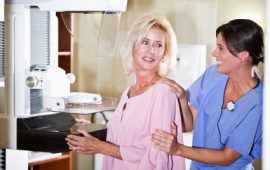Mammograms 101
Author: Shannon Miller Lifestyle

You’ve probably noticed the sea of pink every where you go. Yes, it is Breast Cancer Awareness month! Many consider this month a celebration. Perhaps cancer itself is nothing to celebrate, but what is worth celebrating is the passing on of knowledge. We, as women, need to band together and get the facts circulating!
One of the best ways to detect breast cancer remains the mammogram.
How should you prepare and What should you expect?
- If you still experience menstruation, you should schedule your exam 1 week after your period begins due to the fact that your breasts will be less tender.
- Don’t use deodorant or lotion on the day of your exam.
- Wear clothing that will make undressing easy.
- The exam will be given by a trained radiologic technologist.
- You will be asked to undress from the waist up and then asked to stand next to the x-ray machine.
- First, one of your breasts will be compressed for a few seconds by 2 flat surfaces. Then, your other breast will be compressed.
(The compression part is essential in order to get the best quality picture with the least amount of radiation)
You aren’t alone if you have said things similar to the following about getting a mammogram…
- “I have no breast problems, so mammography isn’t necessary.”
- “I don’t have a family history of breast cancer.”
The truth about the above claims is that they only represent 2, among many, risk factors for breast cancer.
- “I’m scared it will hurt.”
Getting a mammogram may be a little embarrassing and you will feel some pressure, but it only lasts a few moments.
- “I don’t have time.”
Your health is important and moreover, YOU are important. Plus, let’s be honest, an hour (or so) every 2 years is not much time when your talking about early detection of cancer.
Despite your concerns and apprehensions, you should know that mammography screening has been (and still is) the best means of detecting breast cancer early since 1992.
According to the American Cancer Society this three pronged approach will give you the best chance of detecting breast cancer early.
- Mammogram: Yearly mammograms are recommended starting at age 40 and continuing for as long as a woman is in good health
- Clinical breast exam (CBE): About every 3 years for women in their 20s and 30s and every year for women 40 and over
- Breast Self Exam: Women should know how their breasts normally look and feel and report any breast change promptly to their health care provider. Breast Self-Exam (BSE) is an option for women starting in their 20s.
TIP: Always discuss your medical history with your personal physician. Talk to other women (sisters, mothers, daughters, friends) and your healthcare provider – keep an open dialogue to prevent the topic of cancer from developing a stigma in your life.
Sources: “Patient Services/Breast Cancer Q&A.” National Breast Cancer Awareness Month.
“Understanding Mammograms.” Centers for Disease Control and Prevention.
